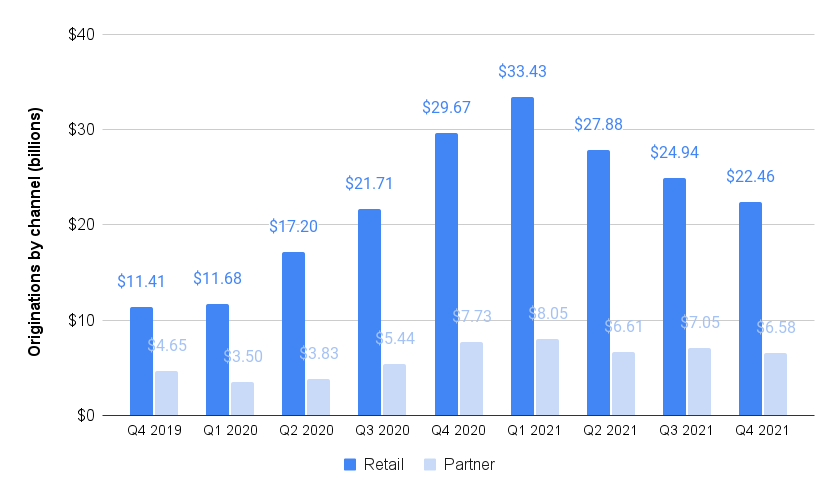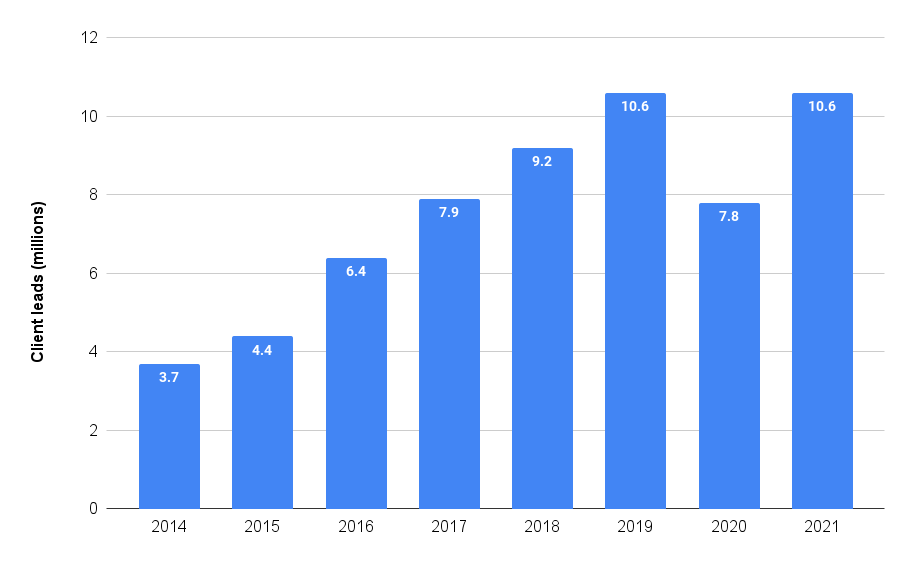As the refinancing boom fades and mortgage industry profits shrink, loanDepot executives say they expect to keep gaining market share as the industry shifts to providing more loans to homebuyers.
Shares in Foothill Ranch, California-based loanDepot touched an all-time low Tuesday, after the company reported fourth quarter net income fell 90 percent from the previous quarter, to $14.7 million. Although loan originations fell by a more modest 9 percent, to $29 billion, tighter profit margins helped drag revenue down 24 percent, to $705 million.
Looking back at 2021 as a whole, loanDepot had its best year ever in terms of loan originations, making $137 billion in loans, up 36 percent from 2020. Those production gains helped the company grow its market share from 2.5 percent in 2020 to 3.4 percent last year, the company said.
But 2021 net income fell to $623 million, down from $2 billion in 2020, as less profitable purchase loans made up a growing portion of the company’s business — 34 percent in the last half of the year, up from 19 percent in the first quarter.
LoanDepot mortgage originations by purpose
Source: Data from loanDepot regulatory filings compiled by Inman.
On a call with investment analysts, LoanDepot CEO Anthony Hsieh acknowledged that the 2020 refinancing boom was a more profitable year. But Hsieh maintains that in the long run, loanDepot’s technology — coupled with a diverse mix of retail, wholesale and partner loan origination channels — will work to the company’s advantage as rising interest rates curtail refinancings.
“Conditions like those we enjoyed in 2020 are when loanDepot drives revenue,” Hsieh said on a conference call with investors. “But the conditions we expect to navigate in 2022 give us an incredible opportunity to capture market share.”
In a year when competitor Wells Fargo closed branches, loanDepot grew the number of in-market retail loan officers by 18 percent, and added four new joint venture partnerships during 2021. Those and other efforts helped boost purchase loan volume by 39 percent, the company said.
“Our business was purpose built with periods of pressure in mind. Our proprietary tech stack, our intentionally diverse mix of channels and our sophisticated performance marketing machine means we control our new flow, our customer contact strategy and the point of loan origination,” Hsieh said. “This is a critical competitive advantage enabling us to pivot and adjust our production as market trends demand. In fact, historically speaking, it’s been during periods of decreasing volume that loan depot’s unique strategy and differentiated assets have resulted in outsized market share growth.”
Investors have been skeptical, however, with loanDepot’s share price dropping more than 10 percent Tuesday, hitting a new all-time low of $4.01 before recovering some of those losses in mid-morning trading. Since a February, 2021 initial public offering priced at $14 a share, shares in loanDepot had traded for as much as $39.85.
“I am a strong believer in this company,” Hsieh said of the lack of investor confidence. “So much so, that in the last quarter I personally bought $10 million of our shares on the open market. In my opinion, loanDepot represents an incredible value and I’m confident we will continue to accelerate our growth, increase our market share, serve our customers, employees, shareholders and communities, while outperforming in the long term.”
LoanDepot sees its end-to-end digital lending platform, mello, which generates rate quotes in seconds and provides a streamlined application process with little or no human intervention, as a competitive advantage.
The company has used mello as a selling point as it builds its purchase loan business through its partner channel, which includes three segments: joint ventures with homebuilders, referal relationships, and loanDepot Wholesale, the company’s “third-party origination” division serving mortgage brokers and correspondent lenders.
LoanDepot signed a joint venture with a national homebuilder partner in December, the fourth such deal of the year, bringing the total joint venture partnerships to 10, the company said.
During the fourth quarter, loanDepot’s partner channel accounted for 22 percent of total originations, or about $6.6 billion in loans. That’s well below the record $8.05 billion in partner channel originations seen during the first quarter of 2021, but the partner channel consistently brings in about one-fifth of loans originated.
LoanDepot mortgage originations by channel

Source: Data from loanDepot regulatory filings compiled by Inman.
LoanDepot and its agent matching subsidiary, mellohome, launched a “Grand Slam package” in August, offering cash rebates of up to $7,000 on bundled services when clients buy and sell with a mellohome preferred real estate agent, finance with loanDepot, and choose the company’s title insurance services.
In December, loanDepot reported that more than 1,400 customers had accepted offers through the program, representing more than $500 million in purchase and sale volume.
LoanDepot client leads, 2014-2021

Source: loanDepot investor presentation.
On the marketing front, loanDepot said its television advertising generated 14.4 billion impressions in 2021, and digital ads accounted for another 876 million impressions, helping boost website traffic 51 percent year over year.
In an investor presentation, loanDepot said its grown client leads by 185 percent since 2014, to 10.6 million in 2021.
LoanDepot said its sponsorship of Major League Baseball’s American League Championship Series and National League Championship Series reached an average of 5 million viewers per game over each six-game series, with 54 commercials aired during those games delivering more than 198 million impressions.
Get Inman’s Extra Credit Newsletter delivered right to your inbox. A weekly roundup of all the biggest news in the world of mortgages and closings delivered every Wednesday. Click here to subscribe.



 Are You Interested in West Eleventh Residences Miami?
Are You Interested in West Eleventh Residences Miami? Are You Interested in ONE Park Tower by Turnberry?
Are You Interested in ONE Park Tower by Turnberry? Are You Interested in Diesel Wynwood Condominium?
Are You Interested in Diesel Wynwood Condominium? Are You Interested in Five Park Miami Beach?
Are You Interested in Five Park Miami Beach? Are You Interested in Cipriani Residences Miami?
Are You Interested in Cipriani Residences Miami? Are You Interested in Bentley Residences Miami?
Are You Interested in Bentley Residences Miami? Are You Interested in Baccarat Residences Brickell?
Are You Interested in Baccarat Residences Brickell? Are You Interested in Aria Reserve Miami?
Are You Interested in Aria Reserve Miami? Are You Interested in 888 Brickell Dolce & Gabbana | Miami?
Are You Interested in 888 Brickell Dolce & Gabbana | Miami? Are You Interested in 600 Miami WorldCenter?
Are You Interested in 600 Miami WorldCenter? Are You Interested in HUB MIAMI RESIDENCES?
Are You Interested in HUB MIAMI RESIDENCES? Are You Interested in WALDORF ASTORIA RESIDENCES?
Are You Interested in WALDORF ASTORIA RESIDENCES?